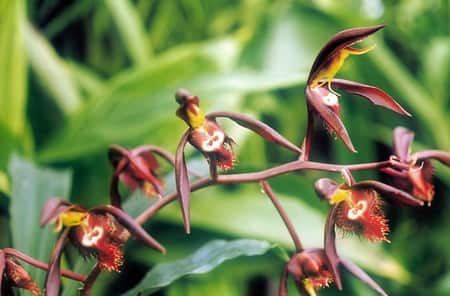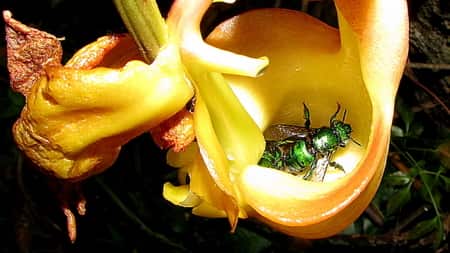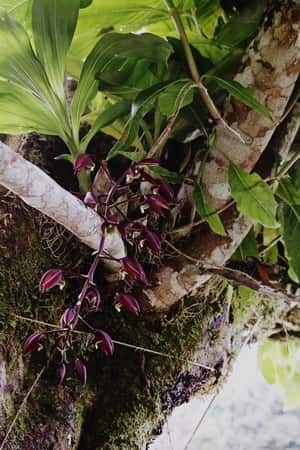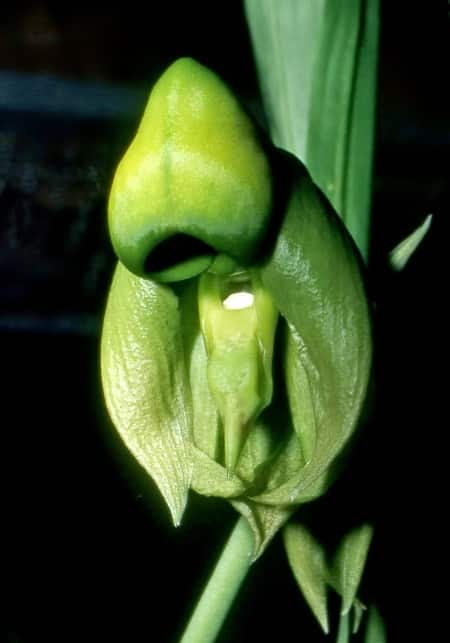In nature, 90% of flowering plants have both functional staminate (male) and pistillate (female) portions in the same blossom. Having both female and male parts is what is called hermaphroditic sex expression—which is normal in the orchid world, too. Only 6 to 7% of all the plants in the world have flowers that are distinctly either male or female, and Catasetum orchids fit in this latter category.
1) What makes Catasetum Orchids so unique?
Catasetum orchids display floral dimorphism when male and female flowers on the same plant are mutually exclusive and differ by size, shape, smell, and growth patterns.
Not only do Catasetum orchids have distinct male and female inflorescences, they also have flowers with both sexes, called hermaphrodite, polymorphic, or unisex flowers. All three blossoms are unique as if they were separate species.
2) Do All Catasetum Orchids Display Floral Dimorphism?
Not all Catasetum Orchids will develop distinct male and female flowers.
Darwin was the first person to suggest that flowers could stray from the norm and present dimorphism—from the Greek “two forms”, either male or female flowers. At that time (1877), he was mocked for suggesting such a far-fetched theory…and here we are today almost 150 years later, studying his theories.
Catasetum orchids were brought under careful observation when they first were introduced. When blossoming occurred, all female or all male flowers formed, which researchers and botanist cataloged as separate species. As time went by, the flowering inflorescence changed from male to female and vice-versa. There is a reason for this which I’ll explain later on.
Catasetum blossoms are quite different when it comes to sexes; the male flower is large, colorful, expansive, and expressive. The female looks like a mourning widow dressed in green. They share hardly any resemblance to each other, and both male and female can bloom on the same plant at the same time.

Image Credit: File:A and B Larsen orchids – Catasetum saccatum 515-22.jpg” by Arne and Bent Larsen, Haarby, Denmark is licensed under CC BY-SA 2.5.  Male Cataseum Saccatum BlossomThe more botanists researched these particular orchids, the more they found that some of the names they had given to one flower could have an inflorescence of another orchid, which they had cataloged as something else—an entirely different species.
Male Cataseum Saccatum BlossomThe more botanists researched these particular orchids, the more they found that some of the names they had given to one flower could have an inflorescence of another orchid, which they had cataloged as something else—an entirely different species.
Finally, taxonomists realized the same orchid species could have two or even three very distinct flowers. …and Darwin was right. The entire subtribe was studied again, as unique flowers emerged with female, male, or unisex blossoms (and sometimes all three). These peculiar orchids were recognized and set aside in their very own group, now called Catasetinae Orchids. This is the subtribe.
Orchids which did not portray the similar dimorphism but had similar growth patterns were also regrouped into a different genus, still under the same subtribe. These 5 unique members of the newly named Catasetinae subtribe were classified as Catasetum, Clowesia, Cycnoches, Dressleria, and Mormodes. (Galeandra and Grobya are in negotiation if they will move subtribes or not. I have not included them in this article.)
Kingdom: Plantae
Clade: Tracheophytes
Clade: Angiosperms
Clade: Monocots
Order: Asparagales
Family: Orchidaceae
Subfamily: Epidendroideae
Tribe: Cymbidieae
Subtribe: Catasetinae
Genus: Catasetum
3) Do All Catasetum Have Male and Female Flowers?
The orchids that showed sexual dimorphism were grouped together as the Catasetum orchids (abbreviated as Ctsm.) and at the time the genus was rearranged. They totaled 166. Now there are more than 180.
It would be so nice if life were that simple.
Dimorphism—go to Catasetum Genus.
All others—stay put.
For some reason that is beyond me, there are a few (around 10) Catasetum orchids that do not show signs of sexual or floral dimorphism. They also don’t have either all male or all female flowers. Their blossoms have both functioning staminate (male) and pistillate (female) in the same flower. Still somehow, these are cataloged as Catasetum. These rare and unique orchids are sometimes referred to as the perfect flowers, showing signs of bisexuality. Some of these include
Catasetum roseum,
Ctsm. warscewiczii,
Ctsm. thylaciochilum,
Ctsm. Russellianum,
and Ctstn. Glaucoglossa.
It didn’t stop with the 10 “fugitive” orchids, wanting to run away from their genus. 26 of the 34 Cycnoches orchid species display this unique characteristic of dimorphism, which means that the other 8 Cycnoches do not.
Why are they not in the Catasetum genus? Floration is not the only way orchids are categorized. There are many other criteria.
I said all that just to reinforce the initial answer: not all Catasetum Orchids will develop distinct male and female flowers. Do your research before purchasing an orchid to find out exactly what species you are acquiring and if it has this trait.
4) Why Do Catasetum Have Distinct Flowers?
The flowers on the Catasetum orchids have adapted to guarantee the propagation of its genus. One of the faithful pollinators of the Catasetum orchid is a bee from the lower elevations of tropical America, called the Euglossine bee. This beautiful, metallic-green bee is the primary pollinator of Catasetum orchids.
I lived overseas in Brazil for more years than I can remember. These bees were everywhere, with their loud buzz and aggravating arrival while we ate. Meal times where the worst. If I had known back then what I do now about these bees, I would have cherished them more. Anyway…
Normally I don’t go out on a tangent, but this one is fascinating. Please bear with me—you’re about to learn why this specific bee is attracted to Catasetum orchids, specifically the male flower, not the female flower.
Female Euglossine bees have only one part to play in this whole, epic drama. That is picking a mate. Since Euglossine bees are monandry (they select only one mating partner), they want to get this down right—no divorce in the Euglossine family.
The female bee doesn’t have a complicated list of what they’d like in a partner, with 20 sub-items as we have. They will choose a mate according to one thing: his pheromones. The female bee chooses the most aromatic male bee. #Focus on the Perfume#
This distinct smell will portray a lot more than what comes to the eye, so it’s not as superficial as it might seem. Smells can tell a lot about a bee: how old he is, his cognitive abilities, how far he can fly, and how forceful or aggressive he is. It’s not just a shallow criterion without any forethought. Of course, male bees know this.
To be successful, they travel long distances to bathe themselves in the best perfume they can find.
The stronger bees will visit more flowers and have unique smells to them.

Euglossine bees visiting Coryanthes speciosa Hook
Male Euglossine bees have patches next to their tibia in their hind legs that store perfume and they undergo a ritual to rub the scent all over their bodies, pushing the fragrance into the pouches. They can go to multiple flowers, as long as they have the strength to do so.
That is where the Catasetum flowers raised the bar.
To be successfully pollinated, the Euglossine bee needs to visit the male flower first. If he visits the female first, the mission is blown. Once landing on the labellum of the male flower (labellum is sometimes called lip and is sometimes the largest petal of the orchid, which forms a landing platform), he needs to receive the pollinia (pollen sac). It needs to attach well. If not, the bee will just kick it off.
The pollinia also needs to stay attached until the bee reaches the female flower—if, that is, he won’t go to another flower. Once leaving the male flower, the bee needs to be guided to the female flower, and the pollen needs to be removed.
Now that’s a lot of milestones. Let’s take them one by one to see how the Catasetum orchids accomplished this by using floral and sexual dimorphism.
5) How Are The Female Catasetum Flowers Pollinated?
The male Catasetum flower has a stronger, purer fragrance than the female flower does. This guarantees that the bee will stop at the male first. After all, his objective is to become fragrant for his female bee prospect. If he can do this with one flower, then his mission is complete, but he wouldn’t be as richly perfumed with various scents. So, he travels on… If you compare both female and male Catasetum flower, the scent of the male flowers is considerably stronger.
TIP: If you’re looking for scented orchids, try this article about the top fragrant orchids. The scent each orchid produces is described, how long it stays in the environment (important if you grow orchids indoors as I do), and what the characteristics of each is. I had fun writing that article. 😊
Once the bee is on the labellum, the Catasetum orchid will violently eject the pollinia onto the bee, aiming for his thorax. This aggressiveness knocks the bee off the flower, disorienting the poor insect. One study reported that the pollinia could be ejected up to nine feet away, so imagine the force. Pollinia isn’t small either, almost half the size of the Euglossine bee.
How does the orchid know when to eject the pollinia? While probing the bottom petal of the orchid, called the lip, the Euglossine bee comes into contact with two hair-like structures above him. If you observe closely, you can see the projected “feelers”, one on each side near the column, or the middle of the flower.
When the orchid sense movement from these two antennae will trigger the ejection of the pollen sac.
The bee has just been slapped by a flower. Even though female bees choose their partners through their cognitive abilities, the male Euglossine bee isn’t that remarkable in terms of “brains”. He remembers that the male Catasetum flower isn’t a pleasant experience, so he won’t go back to it anytime soon—that is, until he forgets. He’ll be back later on.

The next place the male bee flies to is the female flower, which doesn’t offer a threat since it looks nothing like the last unpleasant experience he had on the last aggressive flower.
This is why the female flower has to appear different is shape and size. The perfume isn’t as powerful, but still stronger than most.
It’s a second best to trying again with another male flower and go through the harassment he just endured.
After landing on the female flower, he has to wiggle his way up into a green, monk-like hood that covers the stigmatic cavity.
This hood is actually the lip of the Catasetum orchid. In “normal” orchids, the lip develops just like any other petal. Only towards the end of its development, the lip will invert its place to sit at the bottom of the orchid, to serve as a landing platform for pollinators. This twisting movement is called resupination. If the female Catasetum orchid had such a platform, the bee would land, pick up its scent and leave. The pollinia would still be attached to the bee.
Knowing this, the female orchid blossom doesn’t invert the bottom lip. This is called a non-resupinating orchid. The lip (or labellum) stays on the top axis of the flower, coiling over the center of the orchid, like a shawl.
Incredibly, most all Catasetum female blossoms look alike.These green-hooded flowers are very similar, no matter what Catasetum species it is.
Anyway, the top covering forces the bee to squeeze its way up into the female reproductive system of the orchid.
Mission complete: the female orchid is now fertilized.
TIP: Once the male has ejected the pollinia onto the bee, it will soon fade. You need to be extremely careful upon transport or watering when the flower is open since any small trigger might set off the ejection. Also, once the female flower has received the pollinia, it will do the same: wither and fade.
6) Can Catasetum Have both Male and Female Flowers?
Catasetum orchids aren’t always so textbook. It is normal to consider one plant to produce male flowers on one flowering and if the conditions change, a female inflorescence on the next.
It’s a common feature for Catasetum to produce in the same blooming period both male and female flowers. There are have been inflorescence that will start as female flowers, further up the spike change to male flower, and at the tip have unisex flowers.
7) Can You Induce Male or Female Catasetum Blossoms?
Catasetum, which last 1 to 2 weeks in bloom, can have both female and male flowers on the same plant. Some determinants indicate which sexual traits the blossom will have and as a grower, you can influence the Catasetum orchid.
First, let’s understand what triggers each sexual formation. Female flowers that have been pollinated will close, forming a seed pod. If the flower released the seeds immediately after they were formed, they’d be released during the dry season.
This is when the Catasetum orchid is dormant since there isn’t enough rainfall to keep it alive and well. If the seeds are released during this period, they’d fall on hard dirt, with no nutrients or ways to supply water. This means that the female Catasetum orchid needs to hold onto the seeds, protecting them for up to five or six months when the rainy season comes.

To keep the seeds alive and healthy this long while the rest of the plant is dormant, the flowers need to have store energy.
Energy means light. The brighter the light source and the more hours light is provided to the orchid, the higher the probability of the Catasetum orchid producing female flowers.
The lower the light source, the higher the probability to be male, since their work is already done.
There is a fine line though (isn’t there always?).
Catasetum orchids are light-lovers. Much more than Vandas or Cattleyas. Catasetum thrive in well-lit places, like in the palm trees of open plains and grasslands.
If the seed floated in the air and landed on the shady side of the palm tree or under a covered canopy, the more chances this seed has to be male. If the seed landed on the sunny side, the higher the probability to become female.
To induce the type of Catasetum flower you want, you have to know how much light to give without providing too much (which induces burning the leaves), or too little. They won’t flower properly at all with low light.
Humidity plays a role in deciding whether orchids will have male or female flowers too.
Catasetums need enormous amounts of water and sun. High temperatures and low humidity hinder growth and eventually kill the orchid. If you want more information, I suggest this article that talks about watering Catasetums.
Remember when I said this earlier:
“Catasetum orchids were brought under careful observation when they first were introduced. Initially, when blossoming occurred, all female or all male flowers formed, which researchers and botanist cataloged as separate species. As time went by, the flowering inflorescence changed from male to female and vice-versa. There is a reason for this which I’ll explain later on.”
I didn’t forget about that point, but I had to explain all this before I even touched upon this part of the question.
When Catasetum orchids were studied to be cataloged, the growing conditions were all the same, suffering little variance. It was research. You can’t change the variables all the time.
Once the studies were concluded, the taxonomist would move them out of the greenhouse to another place to call their home.
The light conditions changed. The humidity changed. The environment induced a different set of conditions that changed the disposition of sexual dimorphism…and that is how different flowers on Catasetum orchids appeared.
Don’t Stop Learning!
If you want to be included in more information and get a 14-page fertilization guide, please sign up for my newsletter. I don’t spam, but send emails out bi-monthly with some curious topics of interest. If you want more information, click here to go to a specific page on this website where I explain it more in detail.

Also, if you are looking for an orchid journal to keep your notes specifically about orchid care, check out my 2 solutions for that on this page. If note-keeping isn’t your thing, then there is a free excel spreadsheet that you can download. Click here for more information on how to do that.
If you subscribe to my newsletter, I will send you a 14-page guide on the main tips of orchid fertilizer. It is downloadable and you can print it out on your computer. I designed the guide to double up as a coloring book, just to make it fun.
Further Reading Suggestions:
Don’t just take my word for what is written here. Always continue your research. I like to explain things and make them crystal clear so that anyone can understand them, especially new orchid growers. Unfortunately, that tends to make my articles less academic (and in some peoples eyes, less credible). If you want better and longer explanations, I suggest the articles below.
Catasetum and Cycnoches — Part 2 — Catasetums with Unisexual Flowers written by Stephen R. Batchelor was published on the American Orchid Association. This article goes into more detail of specific species of Catasetum, describing the differences in male and female Catasetum in detail.
written by Stephen R. Batchelor was published on the American Orchid Association. This article goes into more detail of specific species of Catasetum, describing the differences in male and female Catasetum in detail.
The article Sexual dimorphism in flowering plants  written by Spencer C.H. Barrett doesn’t pinpoint Catasetum orchids but explains in great detail of how dimorphism works.
written by Spencer C.H. Barrett doesn’t pinpoint Catasetum orchids but explains in great detail of how dimorphism works.
Orchid Bees (The Euglossines) is one of my favortie articles, with amazing pictures of the Euglossine bee. It was written by Stephen Buchmann, Pollinator Partnership published on U.S. Forest Service website. Well worth the read.
is one of my favortie articles, with amazing pictures of the Euglossine bee. It was written by Stephen Buchmann, Pollinator Partnership published on U.S. Forest Service website. Well worth the read.
Floral Sexual Differentiation in Catasetum Fimbriatum Exposed to Different Light Intensities written by Cristiano Pedroso-de-Moraes .This article is more academic but gets into great detail of how light influences wither male or female Catasetum flowers.
written by Cristiano Pedroso-de-Moraes .This article is more academic but gets into great detail of how light influences wither male or female Catasetum flowers.
I wish you all the best in flowering your Catasetum.
Happy Cultivating!

